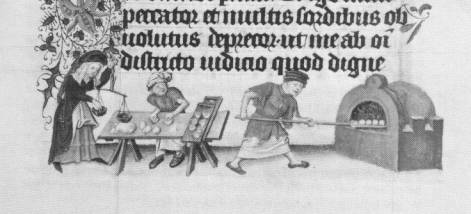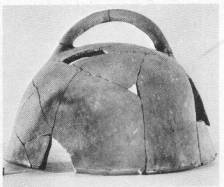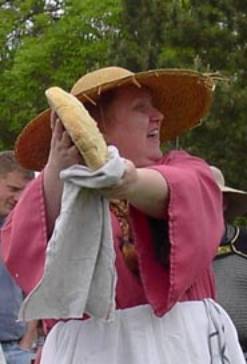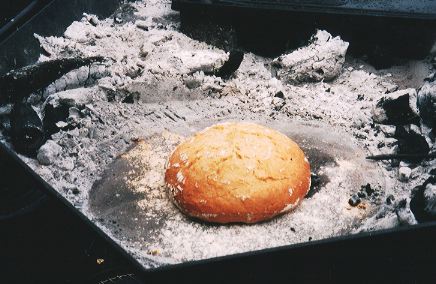
Bakeshop from The Hours of
Catherine of Cleves, mid 15th century, Flemish
An Experiment in Bread Baking
Junefaire 2003
By HL Rycheza z Polska
After Junefaire 2002, I began making plans to demonstrate
medieval cookery at the next Junefaire. I hoped to include bread baking but the
dream of a real oven seemed impractical for a two-day event. There was,
however, an alternative.
Most medieval bread was baked in large wood-fired brick
ovens and was the province of professional bakers. (as in the above
illustration) For smaller or remote households or travelers there were other
less cumbersome alternatives. The bakestone or griddle could be used for
flatcakes and other small breads and with the addition of a baking cloche or
cover could produce a lighter raised loaf. So a baking cloche seemed a viable
alternative for the Junefaire demo.
 My
original cloche was made for me by my daughter in her high school pottery class
with the coil technique and glazed with a food safe glaze. A period cloche may
have been as simple as an overturned bowl or made specifically for baking. Such
a cloche would more likely have been unglazed and have sported a handle as this
Athenian cloche dated 500-480 BC, Similar baking covers were still being used in
the 19th century in country homes in England and Wales. My
original cloche was made for me by my daughter in her high school pottery class
with the coil technique and glazed with a food safe glaze. A period cloche may
have been as simple as an overturned bowl or made specifically for baking. Such
a cloche would more likely have been unglazed and have sported a handle as this
Athenian cloche dated 500-480 BC, Similar baking covers were still being used in
the 19th century in country homes in England and Wales.
A flat-bottomed brazier was used in place of a griddle or
bakestone. First we built a fire on the brazier. This was stoked and allowed to
burn while the loaf was rising. (The recipe used only needs a single rising for
about half an hour.) The cloche was propped nearby on bricks so that the smoke
from the fire heated it as well. When the bread and fire were both ready, the
coals were shoveled off the heated area of the brazier and the area well swept.
After a sprinkling of flour on the hot brazier the bread was placed directly on
the hot metal and the cloche placed over it, sealing the bread inside. The
coals were then heaped around the sides of the cloche and periodically
replenished.

The bread was left under the cloche for about an hour.
(Note that atmospheric conditions such as temperature and humidity will effect
your baking time) The top of the cloche remained warm to the touch during
the entire process.
The first loaf baked was presented to Their Excellencies
Tsuruko and Ralg at opening court, who shared it with the populace. Subsequent
loafs were shared with kitchen staff and others, including a young man in rough
garb who miraculously appeared both days just after the bread was taken out of
the cloche, begging for a crust of bread.
The Recipe:
Medieval loafs baked in this way were most likely a mix of
grains, in particular barley, oats and rye. For this experiment I used a simple
recipe of wheat flour, salt, water and yeast. This recipe is one I use often and
in particular when experimenting with different techniques or grains. It is
reliable and because I am quite familiar with it, I can easily judge the success
of any experiment. (below - a Golden loaf Junefaire 2003)
 Ra's Italian Bread: Ra's Italian Bread:
1 cup warm water
1 package dry yeast
1 1/2 tsp salt
1 1/2 tsp sugar
2 1/2 cups flour
Soften yeast in water, mix all ingredients and knead well.
Shape into loaf , cover and let rise until double (usually
about half an hour)
Bake at 400 degrees 25 minutes
I have used both white and whole wheat flour in this recipe
with good results. Spelt also works well but because of the lesser amount of
gluten tends to spread out more than up. Other grains require adjustments to the
proportions and/or raising and baking time. So far I have only used white flour
in my outdoor experiments.
While this is a modern recipe, if one is willing to accept
the substitution of modern yeast and sugar for the liquid yeast that came from
the brew house, and the reduction in the proportions, it is nearly identical to
this recipe from The Good Huswife's Handmaide for the Kitchen, 1588
Fine
Manchet. "Take halfe a bushell of fine flower twise boulted, and a gallon
of faire luke warm water, almost a handful of white salt, and almost a pinte of
yest, then temper all these together, without any more liquor, as hard as ye can
handle it: then let it lie halfe an hower, then take it up, and make your
Manchetts, and let them stande almost an hower in the oven. Memorandum, that of
every bushell of meale may be made five and twentie caste of bread, and every
loafe to way a pounde besyde the chesill."
Some resources:
David, Elizabeth, English bread and Yeast Cookery /;
introd. and notes for the American cook by Karen Hess ; New York : Viking Press,
c1980. - This has a wealth of information on bread baking from science to
history, it contains several recipes from period sources and many from country
sources that may reach far into the past.
Henisch, Bridget Ann, Fast and Feast, Food in Medieval
Society, The Pennsylvania State University Press, University Park and
London, 1976
Tannahill, Reay, Food in History, , Crown
Publishers, NY, 1973
Toussaint-Samat, Maguelonne, Anthea Bell, Trans.,
History of Food, Blackwell Publishers Ltd., Oxford, UK, 1992
The Good Huswifes Handmaide for the Kitchin.
Bristol: Historical Management Associates Ltd., 1992. Reprint of the original
edition of 1588. ISBN 1858040035. (this book has several bread recipes)
More pictures of our baking experiences are available at
Bread Project
Copyright Rycheza z Polska, mka Laura J.
Henson
posted Dragonslaire.org; Dec 2nd 2004 Posted
Receipt Book of Rycheza z Polska March 17th, 2011
Return to Articles
|